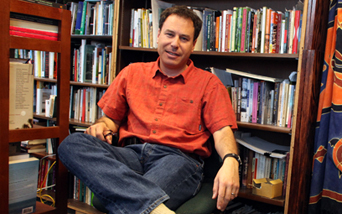The parallels are there, whether it is writing of John Muir’s 1879 journey to Alaska in “A New Literary History of America,” a voluminous, Harvard University Press anthology edited by Greil Marcus and Werner Sollors, or in the living of his own life.
Scott Slovic certainly, like the adventurous Muir, knows what it is like to exuberantly interact with and intellectualize the natural world in rich, meaningful ways.
Not surprisingly, the story behind how Slovic was given the assignment to write an essay on Muir in one of 2009’s most well-received anthologies speaks volumes about Slovic, his talent as one of the country’s foremost voices in environmental criticism, and how he approaches the craft of writing.
“I had long been interested in Muir and had published various things on him, but this project came out of the blue,” said Slovic, a professor of English at the University of Nevada since 1995. “I was in the middle of a trip to Malaysia, where I was spending a few weeks as an outside evaluator for the English Department at the University of Malaya in Kuala Lumpur, and I had a free weekend to travel to Borneo to do some hiking and to interview people about the logging industry in Sarawak.
“I was at the hotel computer in Kuching, checking my email, and Kirsten Silva Gruesz, a contributing editor from UC-Santa Cruz, contacted me and said, ‘Terry Tempest Williams recommended you for this project. The prompt is: March 1879, John Muir’s first trip to Alaska. Can you write something starting with that idea?’”
Slovic, an avid outdoorsman who was a top runner and a frequent hiker in the nearby Cascade mountain range while growing up as a teenager in Eugene, Ore., jumped at the opportunity.
“My basic idea is that John Muir was a lover of all things wild, and when California ceased to be wild enough for him, he set out for Alaska,” Slovic said of the Muir, an immigrant from Scotland who became one of America’s best-known naturalists, beginning with his arrival in the Yosemite valley in 1868. “And he went back to Alaska repeatedly, always trying to push the outer edge of things, testing his limits. In so many of his books and essays, he’s doing things that seem reckless … climbing out on small ledges underneath waterfalls or climbing trees during wind storms in the Sierra, or free-climbing dangerous cliffs and getting himself stuck.”
As he developed his essay, Slovic attempted to answer the question, “Why did Muir need to go to Alaska?”
In an interview in Slovic’s office in Frandsen Humanities during the fall semester, Slovic’s words, when describing Muir, constantly remained in the present. In words and recollection, Muir’s life, like his spirit, seems to stubbornly resist relegation to the past tense.
“He seems to delight in knowing his limits, in pushing the extremity of experience, and that’s one of the many reasons why many American writers seem to value wilderness,” Slovic explained. “It’s a place where we can test ourselves. We learn our boundaries, we learn what we are, when we step outside of our comfortable surroundings and test ourselves against the primal forces and unenhanced landscapes of the natural world.”
Muir, Slovic said, was the embodiment of a person who loved something so much his total immersion in it often threatened to devour him.
“He was,” Slovic added, “seeking new opportunities to experiment with his sense of who he was and what his ultimate relationship was with the universe. So what I’ve tried to develop is a sense of Muir’s experiments pushing the outer limits of his life, tracing that trajectory from him in the late 19th century to the various writers of the 20th century, people from Robinson Jeffers to Edward Abbey, to Terry Tempest Williams, to various other recent writers.”
Easier said than done, Slovic said.
“I had a strict 2,000-word limit, but I wrote 3,000 words,” he said, smiling. “And the editor kept saying, ‘Trim, trim, trim.’”
Slovic’s essay ends with what he calls the “major trajectory,” which links Muir’s experience to that of Christopher McCandless, the young man profiled in Jon Krakauer’s book “Into The Wild,” and, later, the Oscar-nominated film by Sean Penn of the same name. McCandless, who was influenced by the writings of Thoreau and Jack London, set off on a two-year odyssey following his graduation from Emory University in Georgia in 1990. Eventually, he traveled to the wilds of Alaska near Denali National Park. He died there in an abandoned bus.
“When I wrote the Muir essay, I had recently re-read ‘Into The Wild,’ and I’d seen the new film and had even taught them together, which was a great experience,” Slovic said. “These are controversial works for students, because of the radicalism of Chris McCandless’ behavior -- the apparent coldness with which he cut himself off from his family. Many of my students weren’t happy with that: ‘Why was he so cruel to his parents, to his sister? How could he do that?’ What personal mission could’ve inspired him to act in a way that they could not imagine treating their own families?
“To me, there’s a very interesting lineage from Muir to people like Chris McCandless and the journalist/author Jon Krakauer, this idea of needing to know one’s relationship with the universe. It’s about identity: knowing one’s self, and understanding the meaning of one’s life.”
Slovic writes in “The Spirit of These Rocks and Water,” in the Marcus-Sollors anthology that, “Though apparently alone at the time of his death, Christopher McCandless was actually accompanied, in spirit, by Muir, Krakauer, and many other Americans, writers and non-writers, who have sought to reach ever further into the possibilities of the world.”
As Slovic’s career as an academic and writer has evolved, he’s found, that he too, like Muir, enjoys the pulsing excitement of big goals and the next big challenge, of experiencing natural beauty and traveling to lands and landscapes where the familiar and the comfortable are nowhere to be seen.
“I feel in sync with Muir,” he said. “My background and style of writing are different than his. But I appreciate the exuberance of the work. Some people have said that I tend to be very celebratory in my scholarship … and I think that’s my personality. John Muir was called ‘Johnny One-Note’ because he was always in this ecstatic state of euphoria. I actually like that … what’s wrong with a little euphoria now and then?”
More and more, Slovic finds himself working less with the careful deliberation of an academic, and writing with far more impulse, sometimes like a journalist, synthesizing ideas quickly, composing with an electric intensity, and even venturing into entirely unrelated fields of thought.
“For better or for worse, I often find myself plunging into new fields and working out of my background of knowledge,” he said. “If I’m working with new authors or new texts, I quickly dive in. Often it means taking risks and putting myself in situations where a more careful person would know better.”
This past fall semester was a perfect example. Slovic traveled to give lectures in South Africa, Turkey and China. One of his projects was to give a plenary talk on Nobel Laureate Orhan Pamuk, in the writer’s native Turkey. Slovic admitted that his knowledge of Turkish literature was scant, yet it was the intellectually perilous challenge ahead of him that he found stimulating and affirming.
“It often feels that I’m way out of my comfort zone,” he said. “So just as John Muir went to Alaska, I often go to these conferences, having prepared in a hurry, and try to offer perspectives that I think would be helpful to my listeners.
“If you can take familiar topics and issues in new directions, you certainly do feel the energizing, refreshing effects of that process.”












